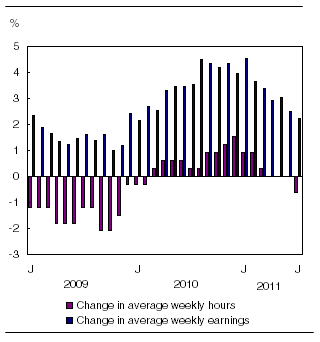In an earlier post, I noted that falling real wages as indicated by July and August data from the Labour Force Survey which showed increases of just 1.4 per cent in nominal hourly wages over the past year signalled trouble ahead: “If this trend continues, it is likely to further undermine a weak recovery, negatively impacting upon consumer spending and perhaps serving as the tipping point to deflation of the housing bubble.”
Today’s Statscan release of SEPH data confirms that real wages are falling. In July, Average Weekly Earnings were up just 2.2 per cent from a year earlier, compared to an inflation rate of 2.7 per cent. While this fall in weekly earnings was partly due to a small fall in weekly hours and also reflects the changing mix of jobs by industry, fixed weight average hourly earnings in July (a stat that controls for the changing mix of jobs) were up by just 1.3 per cent over the past year.
As shown in the following chart taken from the release, the rate of increase of average weekly wages has been falling more or less consistently over the past year.
The Bank of Canada should — and probably will — be concerned about wages increasing at less than the target rate of inflation plus productivity growth, since this could lead to inflation below the target level.
In any case, real wage deflation is definitely not a good thing for working families, and will result in lower household spending and rising unemployment.
Year-to-year change in average weekly hours and average weekly earnings

This article was first posted on The Progressive Economics Forum.



